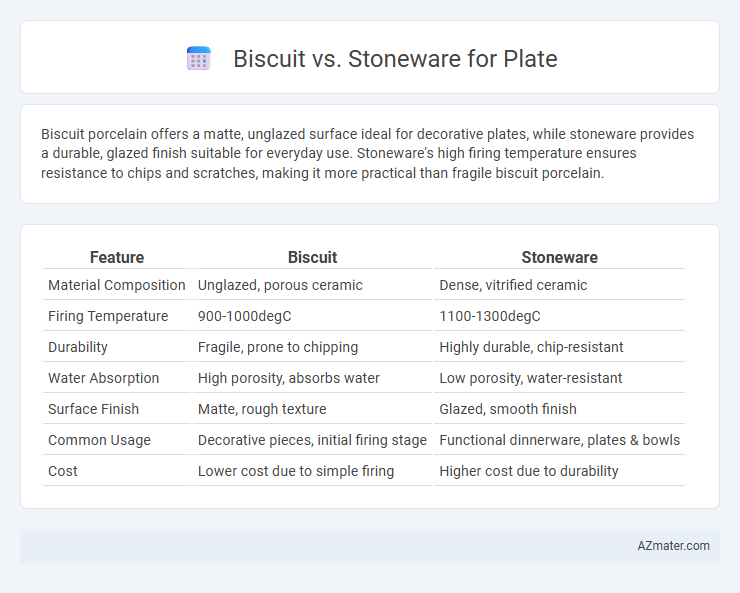Biscuit porcelain offers a matte, unglazed surface ideal for decorative plates, while stoneware provides a durable, glazed finish suitable for everyday use. Stoneware's high firing temperature ensures resistance to chips and scratches, making it more practical than fragile biscuit porcelain.
Table of Comparison
| Feature | Biscuit | Stoneware |
|---|---|---|
| Material Composition | Unglazed, porous ceramic | Dense, vitrified ceramic |
| Firing Temperature | 900-1000degC | 1100-1300degC |
| Durability | Fragile, prone to chipping | Highly durable, chip-resistant |
| Water Absorption | High porosity, absorbs water | Low porosity, water-resistant |
| Surface Finish | Matte, rough texture | Glazed, smooth finish |
| Common Usage | Decorative pieces, initial firing stage | Functional dinnerware, plates & bowls |
| Cost | Lower cost due to simple firing | Higher cost due to durability |
Introduction to Plate Materials: Biscuit vs Stoneware
Biscuit and stoneware are prominent plate materials distinguished by composition and firing techniques, impacting durability and texture. Biscuit refers to unglazed, low-fired porcelain with a matte finish, prized for its delicate, porous surface often used in decorative or fine dining settings. Stoneware undergoes high-temperature firing, resulting in a dense, vitrified material known for robustness, chip resistance, and suitability for everyday use and rustic tableware.
What is Biscuit in Pottery?
Biscuit in pottery refers to unglazed, fired ceramic ware that has undergone its first firing, known as bisque firing, which transforms the clay into a durable, porous state. Unlike stoneware, which is fired at higher temperatures to achieve vitrification and non-porous hardness, biscuit remains porous and ideal for absorbing glazes. This stage is crucial for producing plates with a strong, yet porous base that readily accepts decorative glazes for a finished, functional surface.
Stoneware Defined: Properties and Uses
Stoneware is a durable, non-porous ceramic known for its strength and resistance to chipping, making it ideal for everyday use in plates and dinnerware. Fired at high temperatures between 1200degC and 1300degC, stoneware develops a dense, vitrified body that withstands thermal shock and retains heat effectively. Its versatility extends beyond tableware, commonly used in cookware and decorative items due to its robustness and attractive glaze finish.
Manufacturing Processes: Biscuit vs Stoneware Plates
Biscuit plates are made from unglazed, fired clay known as bisque, which undergoes a single firing process to achieve hardness but remains porous. Stoneware plates are crafted from a denser clay mixture and subjected to high-temperature firing, resulting in a vitrified, non-porous surface that is both durable and water-resistant. The manufacturing process of stoneware involves glazing and a second firing, enhancing strength and aesthetic appeal compared to the more matte and porous biscuit finish.
Durability and Strength Comparison
Stoneware plates offer superior durability and strength compared to biscuit porcelain, as their dense, non-porous composition resists chipping and cracking under heavy use. Biscuit porcelain, being unglazed and more delicate, is prone to surface wear and less impact-resistant, making it better suited for decorative purposes rather than everyday use. The vitrification process in stoneware enhances its toughness, ensuring longer-lasting performance and greater resistance to thermal shock.
Aesthetic Differences: Texture and Finish
Biscuit plates have a smooth, matte finish that offers a soft, velvety texture appealing to minimalist and rustic aesthetics. Stoneware plates present a denser, often glossy or semi-matte glaze, showcasing natural variations and earthy tones that enhance a handcrafted appearance. The tactile contrast between biscuit's unglazed surface and stoneware's sealed finish significantly influences the visual warmth and tactile experience of tableware.
Practical Uses in Everyday Dining
Biscuit and stoneware plates differ significantly in their practical uses for everyday dining due to material properties. Biscuit porcelain, fired at lower temperatures, offers a delicate, matte finish suited for light meals and decorative display but is less resistant to chipping and thermal shock. Stoneware, fired at higher temperatures, provides robust durability, chip resistance, and excellent heat retention, making it ideal for daily meals and oven-to-table use in busy households.
Care, Maintenance, and Longevity
Biscuit porcelain plates require gentle care with non-abrasive cleaning agents to avoid chipping due to their porous and unglazed surface. Stoneware plates offer superior durability and resist stains or scratches better, making them ideal for everyday use with minimal maintenance. Proper storage and avoiding sudden temperature changes extend the longevity of both materials, though stoneware typically lasts longer in high-use environments.
Cost and Value Considerations
Biscuit plates, made from unglazed, fired clay, typically cost less due to simpler production processes but may lack the durability and aesthetic appeal of stoneware plates. Stoneware, a dense, vitrified ceramic, offers higher long-term value through increased strength, chip resistance, and often more intricate designs, justifying its higher initial price. Choosing between biscuit and stoneware plates depends on balancing upfront cost savings against durability and longevity for optimal value.
Which Plate Material is Right for You?
Biscuit porcelain plates offer a smooth, unglazed finish that provides a delicate, matte aesthetic ideal for formal dining and decorative use, while stoneware plates boast a robust, glazed surface known for durability and chip resistance, perfect for everyday use. Choosing between biscuit and stoneware depends on your preference for elegance versus practicality, with biscuit suited for showcasing intricate designs and stoneware excelling in heat retention and ease of cleaning. Consider the frequency of use, maintenance level, and desired appearance to determine whether the refined look of biscuit porcelain or the sturdy nature of stoneware aligns best with your lifestyle.

Infographic: Biscuit vs Stoneware for Plate
 azmater.com
azmater.com